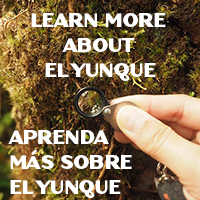Puerto Rican Flycatcher
Puerto Rican Flycatcher(Eng.), Jude Puerto Rico, Copet Puertorrique (Sp.), Myiarchus antillarum (Sci.); distribution Puerto Rico, Vieques, Culebra and US and British Virgin Islands (St. Thomas, St. John, Tortola, Virgin Gorda.)
Photo © 2006 - Flickr.com -creative commons). Information compiled by Alan Mowbray, Interpretive Media Writer, EYNF/LEF
General Information
Taxonomy: Class – Aves, Order – Passeriformes, Family – Tyrannidae,Genus – Myiarchus, Species – M. antilliarum. The Puerto Rican Flycatcher is a tyrant flycatcher endemic to the archipelago of Puerto Rico – it is one of 22 species of the Myiarchus genus of the Tyrannidae family.
Description
The Puerto Rican Flycatcher is approximately 7 inches (18 centimeters) long, weighing 0.8 ounces (23 grams). It has a dark-brown back and light underbody – wings occasionally show two faint buff colored bars.
Habits
M. antillarum sits on lower and middle-level branches, well camouflaged, while waiting to fly-out after insects – prey includes flies, weevils, caterpillars, bees, wasps and dragonflies. Approximately 15% of the diet is reported to consist of berries and fruits. Snails, lizards and frogs will also be occasionally eaten. The Flycatcher’s jaws have reflexive ligaments that cause the jaws to snap-shut when capturing an insect in mid-air. Its song is a waning whistle (click here for recording) which accounts for it’s Spanish name, “Juí.” It nests in tree cavities from February to July, producing a clutch of 3 to 6 yellowish, brown-spotted eggs – incubation is shared by males and females. Young fledge approximately 15 days after hatching.
Interestingly, about five years ago VIS Operations Leader, Victor Cuevas, observed a Puerto Rican Flycatcher and an unrelated endemic, the Puerto Rican Woodpecker building adjacent nests in the same tree in plain view of El Portal’s elevated walkway – the Flycatcher, a “cavity nester” occupied the Woodpecker’s abandoned nest cavity, when the Woodpecker pecked-out a new nest cavity a few feet above what would soon become the Flycatcher’s new home. The two species were then observed to co-exist peacefully during the nesting, hatching and fledging process. When cavity nesters occupy adjacent nests in the same tree, the result may be a “neighborly predator alarm system” that mutually benefits both species.
Habitat
Lower elevation forests, especially coastal scrub and coffee plantations.
Where to look for this animal in the EYNF
The Puerto Rican Flycatcher can be seen (or heard) fairly regularly in the early morning or late afternoon hours on the El Portal Nature Trail below the elevated walkway to the El Portal Rain Forest Center.



